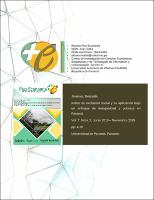Indice de exclusión social y su aplicación bajo un enfoque de desigualdad y pobreza en Panamá
Abstract
The objective is to create an indicator of social exclusion under an inequality approach that allows explaining the dimensions of poverty at the departmentslevel. A cross sectional descriptive study was used, since only the main characteristics and aspects that identify the socioeconomic conditions of the population have to be described quantitatively, and cross-sectional because the data collected refersto a single moment.Information was used as input of 633 departments, obtained in the 2010 Census of Population and Housing carried out by the National Institute of Statistics and Census.Factorial analysis was applied for this study, it is a multivariate analysis technique with the purpose of reducing the dimensions of a numerous set of observed variables.A discriminant analysis is also presented to establish a predictive function for the 21 variables in order to determine the level of exclusion through five classifiers. El objetivo es crear un indicador de exclusión social bajo un enfoque de desigualdad que permita explicar las dimensiones de la pobreza a nivel de corregimiento. Se utilizó un estudio descriptivo transversal, ya que solo se han de describir cuantitativamente las principales características y aspectos que identifican las condiciones socioeconómicas de la población, y transversal porque los datos recolectados se refieren a un solo momento. Se utilizó como insumo la información de 633 corregimientos, obtenida en el Censo Nacional de Población y Vivienda 2010 realizado por el Instituto Nacional de Estadística y Censo (INEC).Se aplicó para este estudio el análisis factorial, es una técnica de análisis multivariante con el propósito de reducir las dimensiones de un conjunto numeroso de variables observadas. También se presenta un análisis discriminante para establecer una función predictiva para las 21 variables en función a determinar el nivel de exclusión a través de cinco clasificadores.
URI
http://jadimike.unachi.ac.pa/handle/123456789/690https://revistas.unachi.ac.pa/index.php/pluseconomia/article/view/418

